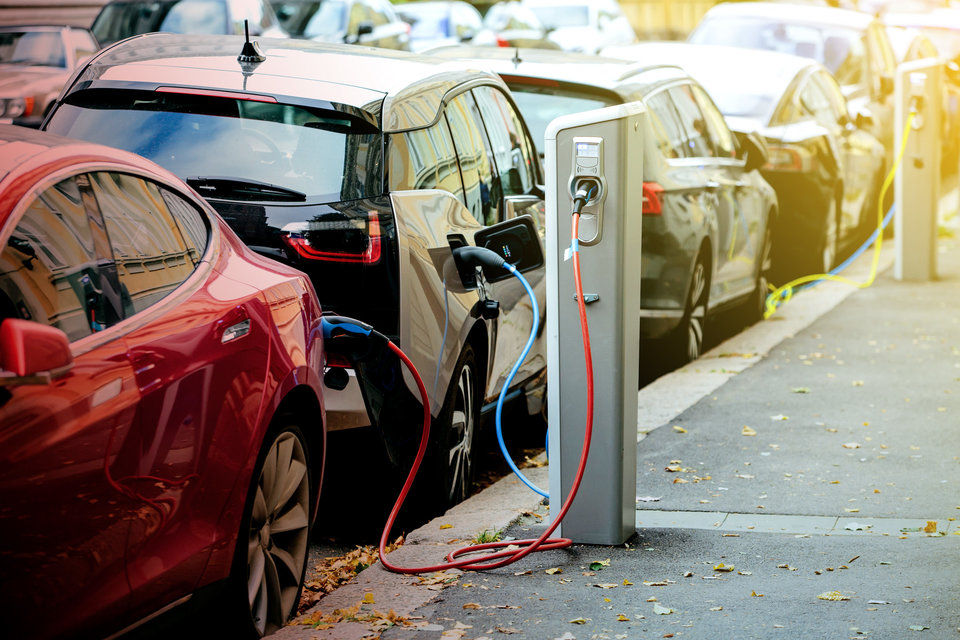Consumer demand
From sideshow to mainstream
In the past decade, electric cars have gone from single figures to more than 10m units worldwide. Much of this has taken place in the past four years. Looking back to the first Cox Automotive and Grant Thornton Insight Report in 2018, global new car sales share for EV was below 2% and the market was in relative infancy. Today, China, Europe and the US are all showing significant growth, with around 3m new electric cars registered in 2020. India is also ramping up, led by investment from Tata Motors, Mahindra & Mahindra, and Suzuki.
Notwithstanding pandemic-induced global contraction in new car registrations in 2020, EV market share now sits at almost 5%. There are various reasons. Model ranges have increased to support manufacturers in managing their total emissions. Governments have provided or extended financial incentives to switch to low emission vehicles. Total cost of ownership is becoming more competitive. Infrastructure roll-out is increasing at pace. The world is creeping ever closer to 2030 and 2050 environmental milestones, while the automotive sector is certainly playing its part in supporting the transition.
With more EVs on the roads and on our screens, consumer exposure is also growing. The most recent World EV Day 2021 saw consumers and businesses representing more than 150 countries participate in online discussion, while it was also spoken about in the UK’s House of Commons and by the White House National Climate Advisor. More than 150m cumulative viewers watched the opening races of the 2021 Formula E season, while the first Extreme E race reached a global audience of 18.7m. Electric vehicles have broken out of the side-lines and joined the mainstream.
If not now, then when?
Philip Nothard, Insight and Strategy Director, Cox Automotive:
“Market share for EV is still comparatively low, but the percentage increases in the past few years have been significant. There are just a few short years until 2030, when the UK and many other global markets will no longer allow the sale of new petrol and diesel vehicles. If governments, manufacturers, and dealers want consumers to engage with the power of electric, then significant investment in education, infrastructure, and connectivity needs to be made today.”
What UK drivers want
Plenty of research has taken place into consumer demand for electric vehicles, much of it showing positive sentiment. In several surveys this year, around a third to a half of respondents expected their next car to be a battery electric vehicle or hybrid. The figure was 44% for eBay Motors Group and 52% for Regit.cars, while research by the AA and Electrifying.com found one in three drivers (34%) thought an electric car would suit their lifestyle right now, with a third (32%) stating going to a petrol station is a chore.
On the Auto Trader marketplace in the UK, one in seven new car advert views (14.3%) in August 2021 was for an electric vehicle, up from 3.8% the previous year. Auto Trader also shared that nearly one in five (17.7%) people are now considering an EV as part of their new car research, up from 8.8% at the start of the year. Incidentally, these figures are similar in the US, where the Kelley Blue Book Brand Watch Report found one in five shoppers researched an electrified vehicle in Q2 2021.
Research from the AA shows consumers want car dealers to do more to support buyers, with half wanting advice on range and how to ensure you never run out of charge (49%); a similar number looking for advice on the charging kit needed at home (44%); and around two fifths seeking explanations about how to claim government financial incentives (37%). This is echoed by Regit.cars data stating almost four fifths (77%) of car owners feel manufacturers and dealers are not doing enough to educate them about electric vehicles.
Regit.cars research also says almost three quarters (72%) of drivers may delay changing their vehicle due to uncertainty around electric vehicles. Only one in 10 (9%) surveyed currently have a charge point at home, and the number who know they have access at work is only slightly higher (12%). Almost three quarters of car owners (71%) felt they were in a position where a domestic charge point could be installed. But nine in ten (92%) believe the UK charging infrastructure isn’t enough to support today’s EV demand.

Perception issues continue around range anxiety and charging reliability. Only a quarter (25%) of drivers in the Regit.cars survey would be prepared to wait more than 30 minutes to receive an 80% charge at a public charging point. Around four fifths (79%) of those surveyed would want an electric vehicle to be able to do more than 200 miles on a full battery for it to be a viable replacement to an ICE model, despite the average length of a car trip in the UK remaining below 10 miles.
AA research also suggests drivers would feel more confident in owning an electric vehicle if they could access a charging point at home (75%); or if they could get charge from any charging point irrespective of who operates it or supplies the electricity (73%). A separate AA poll found a quarter of EV owners (26%) would use their vehicle more if public charging was easier.
Sources: Auto Trader EV Search Trends August 2021; eBay Motors Group Survey August 2021; AA and Electrifying.com Poll April 2021; Regit Electric Vehicle Consumer Survey April 2021; AA Yonder Driver Poll May 2021; Kelly Blue Book Brand Watch Report Q2 2021; AA Yonder Driver Poll March 2021; AA Yonder Driver Poll January 2021
Two sides of the Euro
"It is important to recognise that, while data tends to treat Europe as one homogenous market, there are significant nuances between countries. The Nordics and Northern Europe, for example, are currently running ahead of southern states when it comes to electric vehicle adoption. Larger countries, like Germany, may see a preference for moving to hybrid rather than full EV due to longer commutes and higher business mileage."
Didier Van Bouwel, Chief Operating Officer of Modix International
Overcoming the consumer challenges remaining for EV
As noted in a recent journal article in Transportation Research Interdisciplinary Perspectives, much of the existing consumer research looks at perceptions and purchase intent from non-EV owners rather than satisfaction, loyalty, and repurchase intent from existing owners. While economic and environmental benefits are strong determinants of positive attitude towards electric vehicles, the study echoed previous research which suggests personal considerations around vehicle usage (range and recharge) and the views of peers tend to influence purchase decisions.
Whichever survey or research you read, several key consumer concerns – or functional barriers – remain across global markets. Alongside the cost of the vehicle, these include the reliability of the charging network, where and when to charge, the complexity of paying for charge, and how far vehicles will be able to travel on a single charge. As an example, to respond to these concerns, bp ventures has recently invested €10m in European in-car digital payments provider, ryd, to support the likes of fuel purchases, EV charging, and car washing.
In the UK, work is being done around Vehicle to Grid (V2G) to make it possible for drivers to sell electricity stored in car batteries when demand is at peak levels. Germany is extending existing EV subsidies through to 2025 rather than closing off this year as originally planned. France is offering consumer subsidies, reduced taxes on EVs in cities, and a scrappage scheme for older polluting vehicles. Spain is doing the same. Indeed, much of Western Europe is incentivising EV adoption with financial support packages for consumers, and reduced costs for motoring.

Keeping a hold on ICE vehicles in Canada
Brian Murphy, Managing Director, Kelley Blue Book & Data Solutions, Cox Automotive Canada and Brazil:
“If EVs remain at a significant price premium, you can expect people to want to cling onto the gas-powered wheels as long as possible, further tightening the supply of used ICE vehicles. As the industry transitions, I do think it is reasonable to expect that many vehicles that may have been scrapped in years past will be kept alive by larger investments in repairs. This will create a service shop boom. Look at the example of Cuba; many 1950s cars, from before the revolution, remain in service today with extensive repairs over the past 60 years.”
Financing the electric revolution
Tom Callow, Head of Insight and External Affairs, bp pulse:
“There can be mutual benefits of charging companies providing subscription packages which ensure customer retention and can offer better tariffs. However, for many drivers, especially those who are less frequent travellers, the Pay-As-You-Go option is still more financially viable. In any case, the oft-cited challenge of multiple networks and apps has been mitigated by virtually all new rapid charge points offering contactless payment options.
“In the business market, there is demand for a more integrated solution, similar to the fuel card model but with additional functionality. Some organisations are looking for a single solution which encompasses workplace charging, home charging, public charging and also the more traditional fuel options when required. An all-in-one financed charging solution would also be expected to come with smart data and analytics to allow businesses to make decisions about effective vehicle deployment.”
“There will be an estimated 12-14 million electric vehicles on UK roads by 2030, but at least half the vehicle parc will still be traditional ICE. This does, however, present a challenge to government finances. It isn’t viable to add much higher taxes to electricity because of the impact on so many business sectors. It wouldn’t be feasible to just tax EV charging as this would drive people away from the safe charging options to the ‘dumb’ 3-pin socket approach.
“In the same way, taxing public charging would drive people to home options, which would push demand into peak times and penalise those without off-street parking. There will need to be a different tax regime introduced around vehicle usage, which could be based on the growing ANPR camera network or mileage reports at the annual MOT or insurance renewal period. A rebalancing of motoring taxation will be required to close the gap that electric vehicles will create with the loss of fuel duty.”